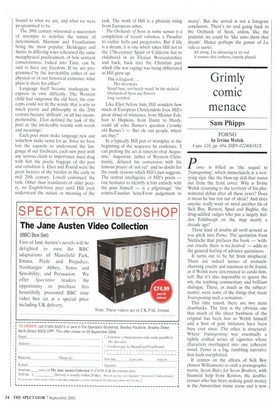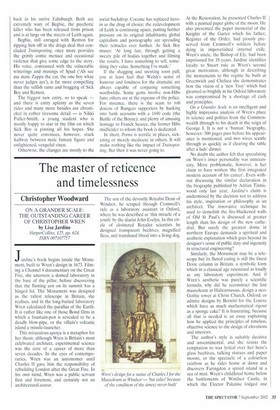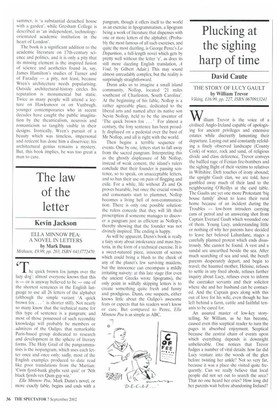Grimly comic menace
Sam Phipps
PORNO by Irvine Welsh Cape, 170, pp. 484, ISBN 02246181X Pomo is billed as 'the sequel to Trainspotting', which immediately is a worrying sign, like the blow-up doll that stares out from the front cover. Why is Irvine Welsh returning to the territory of his phenomenal debut after all these years? Does it mean he has run out of ideas? And does anyone really want or need another fix of Sick Boy, Renton, Spud and Begbie, the drug-addled radges who put a largely hidden Edinburgh on the map nearly a decade ago?
These kind of doubts all swirl around as you pitch into Porno. The quotation from Nietzsche that prefaces the book — 'without cruelty there is no festival' — adds to the general feeling of advance queasiness.
It turns out to be far from misplaced. There are indeed scenes of stomachchurning cruelty and nastiness to be found, as if Welsh were determined to outdo himself. But it's also impossible to ignore the wit, the scathing commentary and brilliant dialogue. These, as much as the subjectmatter, were some of the things that made Trainspotting such a sensation.
This time round, there are two main drawbacks. The first is the obvious one that much of the sheer freshness of the original has been lost as Welsh himself and a host of pale imitators have been busy ever since. The other is structural. Where Trainspotting was essentially a tightly crafted series of vignettes whose characters overlapped into one coherent novel, Porno is a big, rambling narrative that feels overplotted.
It centres on the efforts of Sick Boy (Simon Williamson) to craft a pornographic movie, Seven Rides for Seven Brothers, with financial help from Renton, the doublecrosser who has been making good money in the Amsterdam music scene and is now
back in his native Edinburgh. Both are extremely wary of Begbie, the psychotic killer who has been released from prison and is at large on the streets of Leith again.
Begbie, still enraged with Renton for ripping him off in the drugs deal that concluded Trainspotting, once more provides the grimly comic menace and occasional violence that give some edge to the story. His voice, contrasted with the vulnerable witterings and musings of Spud (`Ah see ma mate Zappa the cat, the one boy whae never judges ays'), is far more compelling than the selfish rants and bragging of Sick Boy and Renton.
The biggest new entry, so to speak — and there is entry aplenty as the seven rides and many more besides are chronicled in rather tiresome detail — is Nikki Fuller-Smith, a young student who is mostly happy to star in the film on which Sick Boy is pinning all his hopes. She never quite convinces, however, stuck halfway between male fantasy figure and enlightened, vengeful vixen.
Otherwise, the changes are mostly to the
social backdrop. Cocaine has replaced heroin as the drug of choice; the redevelopment of Leith is continuing apace, putting further pressure on its original inhabitants; global capitalism and pornography are spreading their tentacles ever further. As Sick Boy muses: At long last, through getting a sweaty pile of bodies together and filming the results, I have something to sell, something they value. Something I've made.'
If the shagging and snorting soon pall, you at least feel that Welsh's sense of humour and fondness for the dramatic are always capable of conjuring something worthwhile. Some gems involve non-Hibs fans; others are at the expense of the police. For instance, there is the scam to rob dozens of Rangers supporters by hacking into bank accounts with a 1690 code (the Battle of the Boyne); and plenty of amusing homage to Franck Sauzee, the former Hibs midfielder to whom the book is dedicated.
In short, Porno is terrific in places, sickening or merely mediocre in others. It will make nothing like the impact of Trainspotting. But then it was never going to.
At the Restoration, he presented Charles II with a painted paper globe of the moon. He also presented the paper memorial of the Knights of the Garter which his father, Register of the Order, had piously preserved from Cromwell's soldiers before dying in impoverished internal exile. Wren's uncle, the Bishop of Ely, had been imprisoned for 18 years. Jardine identifies loyalty to Stuart rule as Wren's second great motivation, although in describing the monuments to the regime he built at Greenwich and Chelsea she demonstrates how the vision of a 'new Troy' which had gleamed so brightly in his Oxford laboratory was compromised by a shortage of cash and principles.
On a Grander Scale is an intelligent and highly impressive analysis of Wren's place in science and politics from the Commonwealth through to his death in the reign of George I. It is not a 'human' biography, however: 300 pages pass before his appearance is mentioned, and two wives scuttle through as quickly as if clearing the table after a lads' dinner.
No doubt the author felt that speculating on Wren's inner personality was unnecessary. More problematic, however, is her claim to have written 'the first integrated modern account of his career'. Even without discussing the similar declaration in the biography published by Adrian Tinniswood only last year, Jardine's claim is undermined by the decision not to address his style, inspiration or philosophy as an architect. The innovative technique he used to demolish the fire-blackened walls of Old St Paul's is discussed at greater length than his design of the new cathedral. But surely the greatest dome in northern Europe demands a spiritual and aesthetic explanation which goes beyond its designer's sense of public duty and ingenuity in structural engineering?
Similarly, the Monument may be a telescope but its fluted casing is still the finest Doric column in Britain, a symbolic form which in a classical age resonated as loudly as any laboratory experiment. And if Wren's aesthetic was purely a scientific formula, why did he reconstruct the lost mausoleum at Halicarnassus, design a neoGothic tower at Christ Church, Oxford, or admire designs by Bernini for the Louvre which have as much mathematical rigour as a sponge cake? It is frustrating, because all that is needed is an essay explaining how he applied the principles of timeless, objective science to the design of elevations and interiors.
The author's style is suitably decisive and unsentimental, and she resists the temptation to wax lyrical over her hero's glass beehives, talking statues and paper moons, or the spectacle of a colourless rainbow as he rides home at dawn and discovers Faringdon a spired island in a sea of mist. Wren's childhood home below the battlements of Windsor Castle, in which the Elector Palatine lodged one summer, is 'a substantial detached house with a garden', while Gresham College is described as 'an independent, technologyorientated academic institution in the heart of London'.
The book is a significant addition to the academic literature on 17th-century science and politics, and it is only a pity that its missing element is the inspired fusion of science and aesthetics found in. say. James Hamilton's studies of Turner and of Faraday — a pity, not least, because Wren's architecture needs popularising. Outside architectural-history circles his reputation is monumental but static. Twice as many people will attend a lecture on Hawksmoor or on Vanbrugh, younger contemporaries who in recent decades have caught the public imagination by the theatricalism, neurosis and romanticism so tangibly visible in their designs. Ironically, Wren's pursuit of a beauty which was timeless, impersonal and reticent has done him a disservice; his architectural genius remains a mystery. But, this book implies, he was too great a man to care.




























































 Previous page
Previous page